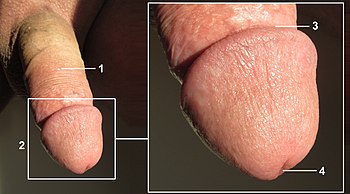Glans penis

As glans penis ( latin glans , acorn ' ) is the glans of the penis of mammals , respectively. This is a thickening at the front end of the penis. In the unigated and uncircumcised state, the glans is at least partially covered by the penile foreskin . During an erection , the foreskin usually pulls back from the glans so that all or part of the glans is exposed. Like the penis itself, the glans also differs in shape and color and is therefore very individual for each boy or man .
construction
A distinction is made between the glans edge ( Corona glandis ) and the glans neck ( Collum glandis ) that adjoins it in the direction of the penis body . In dogs , the very long glans is divided into a long part ( Pars longa ) and an onion part ( Bulbus glandis ).
The glans, along with the frenulum (foreskin ligament) and the inner foreskin, is one of the strongest erogenous zones . The lower edge of the glans is of particular importance. The skin of the glans ( Cutis glandis ) has a thinly cornified squamous epithelium with sebum glands. It has numerous free nerve endings , under the epithelium are Meissner bodies and specialized genital bodies for haptic perception . The epithelium is normally (not circumcised) very thin (2–3 cell layers), so that even the smallest stimuli are perceived. In the circumcised, there is a somewhat more pronounced cornification due to mechanical irritation. The excitation conduction takes place via the dorsal penis nerve and is important for the male orgasm and the ejaculation reflex , among other things .
The inside of the glans is formed by the front section of the urethral cavernous body ( corpus spongiosum penis ), which is also known as the glans cavernous body ( corpus cavernosum glandis ). Its formation and thus also the degree of enlargement of the glans during erection is very different in mammals. In addition to humans, dogs and horses also have extensive erectile tissue . In cloven-hoofed animals , on the other hand, there is hardly any cavernous tissue and the glans is more of connective tissue and only has a venous plexus under the epithelium .
The urethra runs inside the glans . It opens at the tip of the glans with the outer urethral orifice ( Ostium urethrae externum ). In many mammals, the urethra protrudes like a tip over the glans end, which is known as the urethral process ("urethral process"). In horses, the end of the urethra is located in a clear depression, the glans fossa ( fossa glandis ), which has several blind sacs ( recessus ).
The (glans) coronal furrow forms the transition between the glans and penis shaft. Compared to the penis shaft, it thickens. The function of the glans, which is much wider than the rest of the penis, is explained in the phylogenetic sense of sperm competition : During sexual intercourse , the sperm of a male competitor that may be in the vagina of a male competitor is transported out by the movements of the penis, like a barb .
Around 10% of men have a large number of small protruding points on the edge of the glans, the so-called horn tips . These do not represent a disease and do not require any treatment. Such horn formations are also typical in cats, where they are referred to as "penis spines".
Diseases
An inflammation of the glans is technically known as balanitis . It is usually associated with an inflammation of the foreskin ( balanoposthitis ).
Tumors of the penis such as penile carcinoma can also manifest on the glans. The erythroplasia is histologically a true carcinoma in situ .
Psoriasis can also show up on the glans.
In dogs there is one form of tumor that can be transmitted, the sticker sarcoma .
Modifications
Some men have their foreskin removed by circumcision . This reduces the sensitivity of the glans over time, as a protective keratin layer (cornea) forms on the glans. In addition to the medical indication , circumcision is carried out in many cultures mainly for religious and ritual reasons shortly after birth or in early childhood. The circumcision of minors is sometimes criticized as willful bodily harm (see Circumcision - Controversies about the circumcision of minors ).
There are three piercings that run through the glans: the Apadravya (vertical), the Ampallang (horizontal) and the (the) Dydoe through the glans. Splitting the glans and / or the whole penis is called a subincision or bifurcation .
See also
Web links
Individual evidence
- ^ Gordon G. Gallup (Jr), Rebecca L. Burch: Semen Displacement as a Sperm Competition Strategy in Humans . In: Evolutionary Psychology . tape 2 , no. 1 , January 2004, p. 147470490400200100 , doi : 10.1177 / 147470490400200105 ( epjournal.net [PDF; 194 kB ]).



